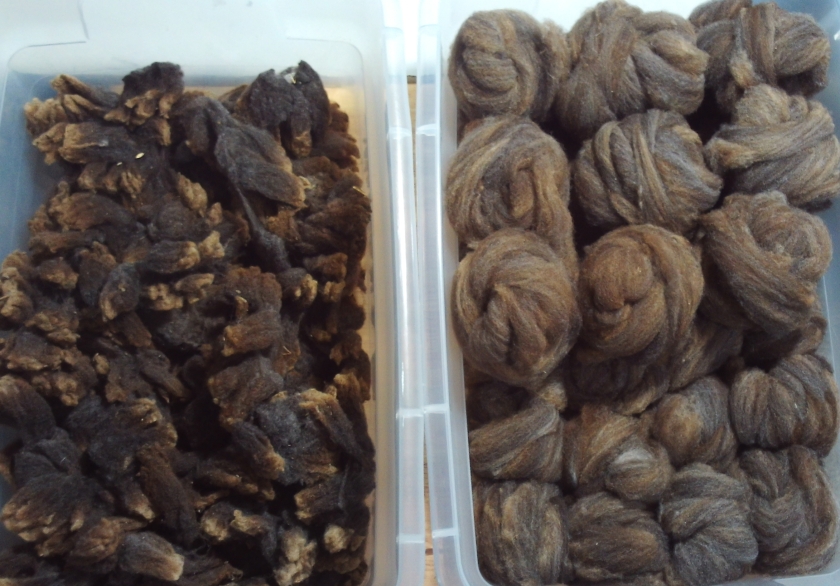I made the trip to the Shetland farm yesterday. It went pretty well. Got a tour of the place. Goats (not fiber breeds), sheep, pigs, chickens and donkeys. She has quite a few more sheep than I thought, 40 or more. Peanuts are the bribe of choice there and the goats are greedy about them. My husband had cashews in his pocket and one of the goats stuck it’s nose right on the pocket as if to say “What have you got in your pocket? I wants it.” After making sure it was ok, he fed a few to a couple of goats who then decided he was their kind of guy.
The sheep were more shy, except for Edith who is the oldest of the flock at 10 years old. She wanted all the peanuts from everyone and was not shy about jumping up on you to demand more. Good thing Shetlands are small. I just treated her the same as a dog jumping on me. I pushed her off and told her no. Hooves hurt a bit more than dog paws tho. The husband got it right in the groin by her, thankfully not too hard.
Then it was time to look at the fiber. I’d already noticed that the fiber on the sheep didn’t look the greatest. Lots of VM, plus she shears late and these being Shetlands, most had already started to roo (shed). The fiber was in clumps, not full fleeces and matting was an issue, plus the vm and those little prickly balls that stick to everything (I call them thistles, but they’re not actually thistles.) Still I can deal with all of that. I picked out my fleeces, 4 lbs of black in two different fleeces and 6 lbs of white/cream from the same animal but 2 different years.
When I got home, I rebagged into pillowcases, just taking out samples from each fleece, which I scoured later that evening.
This is Yankee. Washed on the left. Flicked on the right. Some shockingly long locks in places. I’d have sworn they were two years of growth and that there would be a break in the middle but nope, one strong lock all the way through, except for those yellow tips which came off in the flicking. Some places of seriously heavy VM. Some matting in all the locks but mostly not too bad. But the loss ratio turned out to be pretty high. 4 grams of usable fiber to 8 grams of waste and that doesn’t really include the VM, which got flicked into the garbage can.
Next up are the blacks. The darker one didn’t have a name on the bag. The other is Panda. These are very different in feel and structure than the white. The left side locks had major matting but pulled apart fairly well. Same waste ratio as the white. The right side top chunk turned out to be almost totally unusable. The matting was terrible. I was hoping it would be better with the cute curls on the top. The other chunk was a bit better but still had a lot of matting. This one had 2 grams usable, 10 grams waste.
I paid $10/lb for this fiber and that was a mistake on my part. This is $5/lb fiber at best. The blacks are worth even less (possibly should have been free). I can only hope that I just picked bad bits for my samples and the rest will be better. I didn’t investigate enough on site and to be honest, my natural shyness makes it hard for me to put myself forward and say “This is really bad stuff and I’m not paying $10/lb.” as I should have.
On the other hand, if I had bought fleece online, I’d have probably spent $10/lb plus had to pay shipping. I’d have gotten less fiber, although better quality. It probably comes out even in the end.
After I get a chance to go through the rest of the fiber, I’ll probably send an email of observations and suggestions for improvement. I do know she wants to have a self-sustaining farm and having good fiber to sell is part of that. As it is now, I’m probably the only person who’d buy this stuff (aside from a group on Facebook who specialize in filthy fleeces.) She did have some processed into yarn at a mill a couple of years ago. Maybe that’s where all the good stuff went. Still, from what I saw that was still on the sheep, there’s not a lot of good stuff.
Now I wait for the weather to improve. It’s not bad now, mostly in the 50’s but I need 60’s to wash (so my washtubs aren’t too cold and cool the water too quickly). I’m also not setup yet. Need to get my sorting table out and rig up some sort of shade for me to work under. Heck, we just unburied the washtubs last night. It’s only in the last few days that we’ve had true signs that spring is here. 2 weeks ago we had a nasty snowstorm.
I spindle spun the usable fiber. I need to ply and finish them and do all sorts of measurements before, after and inbetween. I’ll do that tomorrow. I like to let singles rest for at least a day before plying.















































